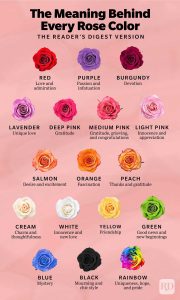
Knowing rose color meanings will help you pick the best rose color for your loved one—on Valentine’s Day and any day of the year
Our editors and experts handpick every product we feature. We may earn a commission from your purchases.
Every rose color has a distinct meaning
We all know that roses are red and violets are blue—but actually, roses can also be blue, pink, orange and even black. And that’s just the beginning. These beautiful flowers come in many different colors, both naturally and with the help of dye. So which rose color should you choose?
Whether you’re buying roses for Valentine’s Day or just because, it isn’t simply about picking the rose color that your love, well, loves. You should also take into consideration what each hue signifies, as rose color meanings can range from love and admiration to friendship and even mourning.
“Roses are the perfect embodiment of love, but their colors have different meanings, which can help customers choose the perfect arrangement for their valentine,” explains Alfred Palomares, vice president of merchandising at 1-800Flowers.com. Interesting piece of Valentine’s Day trivia, right?
Below, you’ll find the various meanings for the popular colors, including the white rose meaning, the red rose meaning and more! Just in time for the most romantic and rose-centric day of the year, here’s what you need to know about rose color meanings so you can send the perfect Valentine’s Day flowers to the people you love.
Certainly! Here is a description of the flower in the image, focusing on its potential benefits:
The image shows a beautiful, fully bloomed rose. The rose is a vibrant shade of pink, with numerous petals tightly clustered together to form a rounded shape. The petals have a velvety texture and appear to be slightly ruffled at the edges. The flower is showcased against a plain, light-colored background, which helps to highlight its color and intricate details.
Potential Benefits:
Roses are not only visually appealing but also possess various benefits:* Beauty and Aesthetics: Roses are widely recognized for their beauty and are often used in decorative arrangements, bouquets, and landscaping to enhance the visual appeal of spaces.
* Aromatic Properties: Many roses are known for their fragrant scent, which can create a calming and uplifting atmosphere. Rose essential oil is often used in aromatherapy to promote relaxation and reduce stress.
* Culinary Uses: Rose petals are edible and can be used to add a delicate flavor and aroma to various dishes, such as desserts, teas, and jams.
* Medicinal Properties: Rosehips, the fruit of the rose, are rich in vitamin C and other antioxidants. They are often used to make teas and supplements that are believed to boost immunity and support overall health.
Note: While roses offer various potential benefits, it’s important to exercise caution if you plan to consume any part of the plant or use rose products, as some individuals may experience allergies or sensitivities.
Let me know if you would like a more detailed description of any specific aspect of the flower or its potential uses!
Here are some other ideas based on the information provided:
1. Rose-themed Wellness Product:
* Concept: Create a line of bath and body products infused with rose essential oil or rosehip oil. This could include bath bombs, soaps, lotions, and massage oils.
* Benefits: Emphasize the potential stress-reducing and skin-soothing properties of rose for a relaxing and rejuvenating experience.
2. Gourmet Rose Food Products:
* Concept: Develop a range of gourmet food products featuring edible rose petals. This could include rose petal jams, rose petal infused honey, rose petal tea blends, or even rose petal infused chocolates.
* Benefits: Highlight the unique flavor and aroma of rose petals to create a luxurious and indulgent culinary experience.
3. Rose-inspired Home Decor:
* Concept: Design and create home decor items inspired by the beauty of roses. This could include rose-printed textiles, rose-shaped candles, rose-themed wall art, or even dried rose arrangements for home decoration.
* Benefits: Offer aesthetically pleasing and fragrant home decor options that bring the beauty of nature indoors.
4. Rose-themed Educational Workshop:
* Concept: Organize a workshop or class focused on the history, cultivation, and uses of roses. This could include demonstrations on rose pruning, rose water distillation, or rose petal cooking.
* Benefits: Provide a unique and engaging educational experience for those interested in learning more about roses.
Remember: When developing these ideas, consider the target audience, market demand, and potential competition.
If you’d like, tell me more about your interests or any specific direction you’d like to explore, and I can provide more tailored suggestions.



One Comment on “17 Rose Color Meanings to Help You Pick the Perfect Bloom Every Time”